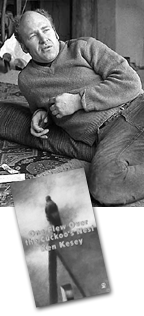Sometimes a Great Notion
A toast to the late great Ken Kesey
"[Ken Kesey] has found out a way to live out there where the real winds blow."
-Hunter S. Thompson
When Bob Costas interviewed Ken Kesey in the early 90s and asked about why he'd done the things he'd done in his life, Kesey's response was because he was an American. And he identified Americans as "searchers and pioneers."
Kesey's death last week, at 66, marked the end of an era for many fellow searchers, seekers, drifters, and those who straddled the bridge between the beats and the hippies.
Kesey has described the "divide" as "the cracker generation."
In the literary world, the author is probably best known for One Flew Over the Cuckoo's Nest (1962) - Milos Forman's film adaptation later went on to win five Oscars - and later, Sometimes a Great Notion. The novel Sailor Song was published in 1992, to reviews which ranged from mixed to vicious. 
Sociologically, he will long be remembered for the formation of the Merry Pranksters, and their cross-country bus trip on Furthur, chronicled in Tom Wolfe's The Electric Kool-Aid Acid Test.
As a former student of the infamous Wallace Stegner at Stanford, Kesey befriended several writers who would go on to become mainstays in Kentucky's literary scene.
His other infamous friends went on to include everyone from Larry McMurtry (who was in a writing workshop with him at Stanford), to Neal Cassady to the Warlocks (who went on to become the Grateful Dead).
Kentucky's population of Stegner fellows includes Wendell Berry, Gurney Norman, Ed McClanahan and Bobbie Ann Mason.
McClanahan has written at some length on his longtime friendship with Kesey (in essays included in Famous People I Have Known and My Vita, If You Will) - including their Palo Alto party days, and the counterculture community that surrounded Kesey.
Kesey visited Kentucky for a reading at the Opera House in the 90s, and spoke about his attempt to foist a bus onto the Smithsonian (they didn't want it), and his new adventures meeting college students and trying to reawaken the spirit of the 60s.
Voted "most likely to succeed" in high school (and a subsequent recipient of the Woodrow Wilson fellowship at Stanford), Kesey seemed an unlikely figure to lead his generation onto the bridge that spanned the 50s beats and the 60s hippies, but many credit him with accomplishing just that.
Possibly more famous for his lifestyle and activism - growing out of his college days where he volunteered to take part in a government drug research program that tested a variety of psychoactive drugs such as (then-legal) LSD, psilocybin, mescaline, and amphetamine IT-290.
To his dying day, he proclaimed that the 60s were not over, and that they would not be until "the fat lady gets high."
He credited the era with the rise of environmentalism, feminism, civil rights and the psychedelic movement, which he saw as a path to enlightened consciousness.
He frequently compared the work he did with "plowing the ground," and often credited Gurney Norman with the analogy.
-Staff
HOME | THIS ISSUE | ACE ARCHIVES